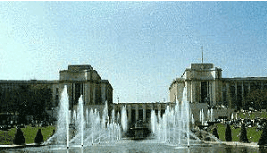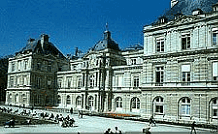The palaces
LE PALAIS DE CHAILLOT

© Pariserve.com
17 place. du Trocadéro (16è)
M° Trocadéro
Opening:
9.45 -17.15 Wednesday - Monday
In the 16th century Catherine de Medici had
a pleasure house built on the hill of Chaillot, the house then
passed on to the Maréchal de Bassompière. The Maréchal
would later be sent to the Bastille by Richelieu and there, it
is said, he burned over 6,000 love letters that he had received
throughout his life as a man of leisure.
The Trocadéro takes its name from the fort of Cadiz, taken by the French in 1823 in order to re-establish the absolute monarchy in Spain. The Palais du Trocadéro, the architecture of which was inspired by Moorish art was built for the World’s Fair of 1878, and it is on the site of that palace that the current Palais du Chaillot was built for the World’s Fair of 1937.
The Palais de Chaillot is the work of the architects: Azema, Carlu and Boileau and is formed by two curved wings that descend towards the Seine. Between the two wings is the Esplanade des Droits de l’Homme, the view from which is dominated by the Eiffel Tower and the Champ de Mars. Within the palace are several museums: the museum of man, of cinema, of the sea, as well as a cinematic library.
cinémathèque.
LE PALAIS DU LUXEMBOURG

Source:
www.parisbalades.com
15 rue de Vaugirard (6è) M° Odéon
Tel: 01 42 34 20 00
Opening: Organised visits only the
senate The site which, today, is home to the gardens
and palace of Luxembourg was originally a Roman camp. When the
Chartreux moved there in 1257, this verdant place had an ill reputation,
and was even considered by some to be cursed. The Chartreux transformed
it into a flourishing convent. Maria de Medici bought in 1612 the house of the
Duke of Luxembourg and there, in 1615, she had her palace built
by Salomon Brosse in the Renaissance style to remind her of her
native Tuscany. Despite their exile, the palace remained the property
of the royal family up until the revolution. The gardens were
extended to reach on to the land of the Chartreux, and today offer
a splendid setting for walkers. The Palais de Luxembourg is the
senate
convenes.
LE PALAIS ROYAL

© Pariserve.com
His great grandson Philippe Egalité would later have a number of shop buildings constructed around the gardens, as well as the Théâtre Français.
During the revolution the Palais Royal was at the centre of events, turning indeed, into a den of debauchery. It was the setting for gaming houses as well as brothels. From 1801 the palace became home to the tribunal, then to the stock exchange, then to the court of commerce. It was restored to the Orléans family in 1814. In 1871, during the events of the Commune of Paris, the palace was set alight. It was restored, however and from 1875 to the present day has hosted the Council of State. One can admire there Buren’s columns, which despite a certain amount of controversy, fit in perfectly with the surroundings.
LE GRAND PALAIS

© Pariserve.com
Avenue Eisenhower (8è) M° Champs Elysées
Clémenceau Tel: 01 44 13 17 30
Opening: 10.00 -17.45 Tuesday - Sunday (payment on admittance) The Grand Palais was built for the World’s
Fair of 1900 and was devoted to the Art Nouveau style. The works
began in 1897, following the designs of the architects Deglane,
Louvet and Thomas. It measures 240m long and 40m tall. The Ionic
columns and monumental porch of the façade allow a view
from the outside of Recipon’s chariots. Altogether, it forms
a successful fusion of iron, stone and glass. The central cupola,
made of glass, lets in light during the day and offers a magnificent
view of the outside when lights reflect on it in the evening.
LE PALAIS DE LA DECOUVERTE

© Pariserve.com
Avenue. Franklin Roosevelt (8è) M° Franklin
D. Roosevelt Tel: 01 40 74 80 00
Opening:
09.30 -18.00 Tuesday – Saturday and 10.00 –
19.00 Sunday (payment on admission) Set off for the Palais de la Decouverte to find
out about specific fields of science (chemistry, electrostaticity,
biology). This building allows anyone to become interested in
science. The layman will have his interest piqued by the numerous
experiments on display, while those initiated will find a fountain
of information to improve their knowledge. Lastly, the planetarium
gives visitors the chance to take a voyage through space and time.
LE PETIT PALAIS

© Pariserve.com
10.00 -17.45 Tuesday - Sunday (payment on admission) Built at the same time as the Grand Palais for the World’s Fair 1900, in the art nouveau style, the small palace shelters a wide range of artistic creations (antiquity, renaissance, 17th century). Within can be found the Museum of Fine Arts.
For more information : category "Monuments/Buildings".
Of course, Paris has many more monuments to offer, such as
the Unmissable Attractions
or Icons of Paris.
Enjoy your visit!
- Paris-city Partners :
- Music News
- Rock, Jazz & Blues CDs
- Learn French in Paris
- Learn French in France
- Paris Junior Programs
- Learn English in England
- Business English Courses
- Need a translation?
- For teachers of French
- French Exercise & Tests
- Directories
- English courses for Teens in UK
- Camps for Teens in England
- Language Courses Abroad
- English courses in England
- Learn a Language Abroad


